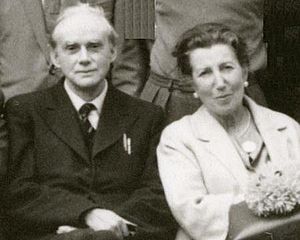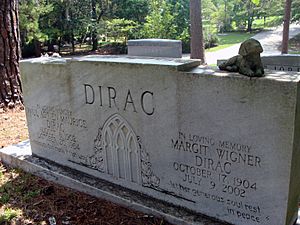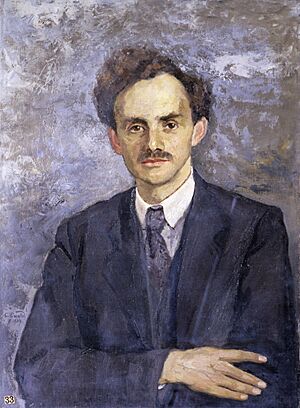Paul Dirac facts for kids
Quick facts for kids
Paul Dirac
|
|
|---|---|

Dirac, photographed in 1933
|
|
| Born |
Paul Adrien Maurice Dirac
8 August 1902 Bristol, England
|
| Died | 20 October 1984 (aged 82) Tallahassee, Florida, U.S.
|
| Nationality | British |
| Alma mater | |
| Known for |
|
| Spouse(s) |
Margit Wigner
(m. 1937) |
| Children | 2 |
| Awards |
|
| Scientific career | |
| Fields | Theoretical physics |
| Institutions | |
| Thesis | Quantum mechanics (1926) |
| Doctoral advisor | Ralph Fowler |
| Doctoral students |
|
| Influences | John Stuart Mill |
Paul Adrien Maurice Dirac (8 August 1902 – 20 October 1984) was a brilliant theoretical physicist from England. He is considered one of the most important physicists of the 20th century. He was a professor at the University of Cambridge, Florida State University, and the University of Miami. In 1933, he won the Nobel Prize in Physics.
Dirac made huge contributions to the early ideas of quantum mechanics (how tiny particles behave) and quantum electrodynamics (how light and matter interact). He created the Dirac equation, which explains how particles called fermions (like electrons) act. This equation also predicted that antimatter exists! Dirac shared his 1933 Nobel Prize with Erwin Schrödinger for their work on atomic theory. He also helped connect general relativity (Einstein's theory of gravity) with quantum mechanics.
Dirac was known for being very quiet and precise. Albert Einstein once wrote about Dirac's work, "This balancing on the dizzying path between genius and madness is awful."
Contents
Paul Dirac's Life Story
Growing Up in Bristol
Paul Adrien Maurice Dirac was born in Bristol, England, on 8 August 1902. He grew up in the Bishopston area of the city. His father, Charles Dirac, was from Switzerland and taught French. His mother, Florence Dirac, was from Cornwall and worked as a librarian. Paul had a younger sister, Betty, and an older brother, Felix, who sadly died in 1925.
Paul's father was very strict. He made his children speak only French to him. If Paul couldn't say what he wanted in French, he would just stay silent. This might have made him a quiet person later in life. The family became British citizens in 1919.
Dirac's Education Journey
Dirac first went to Bishop Road Primary School. Then he attended Merchant Venturers' Technical College, where his father taught French. This school focused on practical subjects like engineering and modern languages, which was unusual for the time. Dirac was grateful for this type of education.
He studied electrical engineering at the University of Bristol and earned a degree in 1921. Even though he was a top student, he couldn't find a job as an engineer because of the tough economy after World War I. So, he decided to study mathematics at the University of Bristol for free.
In 1923, Dirac graduated again with top honors. He then received scholarships that allowed him to study at University of Cambridge. There, he became very interested in general relativity and the new field of quantum physics. He earned his PhD in June 1926, writing the first-ever thesis on quantum mechanics.
His Family Life

In 1937, Dirac married Margit Wigner, who was the sister of another famous physicist, Eugene Wigner. Margit had two children from a previous marriage, Judith and Gabriel, whom Dirac raised as his own. Paul and Margit also had two daughters together, Mary Elizabeth and Florence Monica.
Margit, often called Manci, played an important role in Dirac's life. She took care of everything else, allowing him to focus on his research. This helped him continue to publish many important scientific papers.
Dirac's Quiet Personality
Dirac was famous among his friends for being very precise and not talking much. His colleagues at Cambridge even joked that a "dirac" was one word per hour!
Here are some stories about his personality:
- When Niels Bohr was struggling to finish a sentence in a paper, Dirac simply said, "I was taught at school never to start a sentence without knowing the end of it."
- He didn't like poetry. He once told physicist J. Robert Oppenheimer, "The aim of science is to make difficult things understandable in a simpler way; the aim of poetry is to state simple things in an incomprehensible way. The two are incompatible."
- Dirac wrote in his diary that he only stopped working on Sundays, when he would take long walks by himself.
- Once, on a ship to Japan, Werner Heisenberg asked Dirac why he danced. Dirac replied, "But, Heisenberg, how do you know beforehand that the girls are nice?"
- When he first met the young Richard Feynman, Dirac said after a long silence, "I have an equation. Do you have one too?"
- After a lecture, someone said, "I don't understand the equation on the top-right-hand corner of the blackboard." After a long silence, Dirac replied, "That was not a question, it was a comment."
Dirac was also very modest. He called an important equation he discovered the "Heisenberg equation of motion." He also preferred to call "Fermi-Dirac statistics" simply "Fermi statistics," and "Bose-Einstein statistics" simply "Bose statistics," for "symmetry."
Dirac's Views on Religion
Dirac had strong views about religion when he was younger. He saw religion as something that could be used for political reasons. Later in life, his views became a bit softer. He thought that the existence of God could only be explained if a very unlikely event had happened in the past. He didn't say he believed in God, but he thought science might one day answer the question.
Dirac's Amazing Career in Physics
Dirac created the most complete theory of quantum mechanics. He also discovered the Dirac equation for the electron, which is named after him. This equation led to the amazing idea that every particle has an antiparticle (like the positron, which is the antiparticle of the electron).
He was the first to develop quantum field theory, which is a key part of understanding tiny "elementary" particles and the forces of nature. He also thought about the idea of a magnetic monopole, which is like a magnet with only one pole (north or south). Scientists are still looking for these!
How Quantum Theory Began for Dirac
Dirac's journey into quantum theory started in 1925. His supervisor, Ralph H. Fowler, showed him a paper by Werner Heisenberg. Heisenberg's paper used new mathematical ideas to describe how particles behave.
Dirac noticed a strange mathematical pattern in Heisenberg's work. A few weeks later, he realized this pattern was similar to something in classical mechanics called "Poisson brackets." Using this idea, he developed a new quantum theory based on "non-commuting" variables. This led to his most important and general way of describing quantum mechanics. For this work, published in 1926, Dirac earned his PhD. His ideas also formed the basis for Fermi-Dirac statistics, which explains how many identical particles (like electrons) behave.
Dirac was not worried about how to "interpret" quantum theory. He focused on the fundamental mathematical ideas.
The Famous Dirac Equation
In 1928, Dirac created the Dirac equation. This equation describes how electrons move at very high speeds, following Einstein's theory of relativity. This groundbreaking work led Dirac to predict the existence of the positron, which is the electron's antiparticle. The positron was discovered by Carl David Anderson in 1932, proving Dirac right! The Dirac equation also helped explain why particles have a property called quantum spin.
Later, in 1934, Werner Heisenberg reinterpreted Dirac's equation. It became a fundamental equation for all elementary matter particles, like quarks and leptons. Today, the Dirac field equation is as important in physics as Maxwell's equations (for electromagnetism) and Einstein's field equations (for gravity). Dirac is seen as the founder of quantum electrodynamics (QED). He also introduced the idea of vacuum polarisation. His work was essential for later physicists like Julian Schwinger, Richard Feynman, and Shin'ichirō Tomonaga to develop modern QED.
Dirac's book, The Principles of Quantum Mechanics, published in 1930, is a very important book in science history. It became a standard textbook and is still used today. In it, Dirac combined the ideas of Werner Heisenberg and Erwin Schrödinger into one clear mathematical system. He also introduced the Dirac delta function and the widely used bra–ket notation.
Magnetic Monopoles: A Mystery
In 1931, Dirac suggested that if just one magnetic monopole existed in the universe, it would explain why electrical charge always comes in specific amounts (is "quantized"). Scientists have looked for magnetic monopoles, but so far, there is no direct proof that they exist.
Working on Gravity
Dirac also worked on how to apply quantum ideas to gravity. He developed a general theory for quantum fields with "dynamical constraints." This work is now the basis for modern gauge theories and superstring theories. Dirac's ideas and equations are used by physicists every day.
At the University of Cambridge
Dirac was the Lucasian Professor of Mathematics at the University of Cambridge from 1932 to 1969. This is a very famous position, once held by Isaac Newton! During World War II, he did important research on how to enrich uranium for nuclear energy.
Dirac was not happy with some parts of quantum electrodynamics (QED). The equations often produced results that were "infinite," which didn't make sense. Scientists developed a method called renormalisation to deal with these infinities. But Dirac never accepted it. He said in 1975, "This is just not sensible mathematics." Because of this, some of his later work moved away from the main ideas in physics at the time.
However, he continued to work on QED using his own methods. In 1963, he found a new way to calculate important effects like the anomalous magnetic moment and the Lamb shift.
Later Years in Florida
After leaving Cambridge, Dirac moved to Florida to be closer to his elder daughter, Mary. He spent his last fourteen years doing physics research at the University of Miami and Florida State University.
In the 1950s, Dirac developed the "Hamiltonian theory of constraints." This was a powerful way to describe systems where particles are limited in their movement. He also applied these methods to Einstein's theory of general relativity, helping to bring the quantum understanding of gravity closer to other areas of physics.
From 1970 to 1971, Dirac was a visiting professor at Florida State University. He liked it so much that he accepted a permanent position there in 1972. He was more social in Florida than he had been in Cambridge. He would walk to work, swim in nearby lakes, and often eat lunch with colleagues.
Dirac published over 60 papers in his last twelve years. His last paper, in 1984, was called "The inadequacies of quantum field theory." In it, he still expressed his doubts about parts of quantum field theory. He wrote, "I have spent many years searching for a Hamiltonian to bring into the theory and have not yet found it. I shall continue to work on it as long as I can and other people, I hope, will follow along such lines."
Dirac's Students
Many famous physicists were students of Dirac, including Homi J. Bhabha, Fred Hoyle, John Polkinghorne, and Freeman Dyson. John Polkinghorne remembered that when Dirac was asked about his main belief, he went to a blackboard and wrote that the laws of nature should be expressed in beautiful equations.
Awards and Recognition
Dirac shared the 1933 Nobel Prize for physics with Erwin Schrödinger. He also received the Royal Medal in 1939, and both the Copley Medal and the Max Planck Medal in 1952. He became a Fellow of the Royal Society in 1930. In 1973, he became a member of the Order of Merit, a special honor in the UK. He had previously turned down a knighthood because he didn't want to be called by his first name.
His Passing and Memorials


Dirac passed away in Tallahassee, Florida, in 1984 and was buried there. His childhood home in Bishopston, Bristol has a special blue plaque, and a nearby road is named Dirac Road. In Saint-Maurice, Switzerland, his father's hometown, a stone was placed in his memory in 1991.
On 13 November 1995, a special stone marker with the Dirac equation carved into it was placed in Westminster Abbey in London. This is a very high honor, as Westminster Abbey is a famous church where many important British figures are buried.
Dirac's Lasting Legacy
In 1975, Dirac gave a series of lectures that were published as a book called Directions in Physics. He gave the money from this book to the University of New South Wales to start the Dirac Lecture Series. The Silver Dirac Medal is awarded by this university to honor his lectures.
After his death, two physics organizations created annual awards in his memory. The Institute of Physics in the UK gives the Paul Dirac Medal for great work in theoretical physics. The International Centre for Theoretical Physics awards the Dirac Medal of the ICTP every year on Dirac's birthday, August 8.
At Florida State University, the Dirac-Hellman Award supports theoretical physics research. The Paul A.M. Dirac Science Library at Florida State University is named after him, and his papers are kept there. There is also a statue of him outside the library. A street in Tallahassee, Florida, is named Paul Dirac Drive. There's also a road named Dirac Place in Didcot, England.
The BBC even named a video codec, Dirac, after him. An asteroid discovered in 1983 was also named after Dirac. The Distributed Research utilising Advanced Computing (DiRAC) and Dirac software are also named in his honor.
Images for kids
-
Dirac (front row 3rd from left), next to Éamon de Valera (front row 4th from left), Erwin Schrödinger (front row 2nd from right) at Dublin Institute for Advanced Studies in 1942.
-
The 1927 Solvay Conference in Brussels, a gathering of the world's top physicists. Dirac is in the center of the middle row, seated behind Albert Einstein.
See also
 In Spanish: Paul Dirac para niños
In Spanish: Paul Dirac para niños




